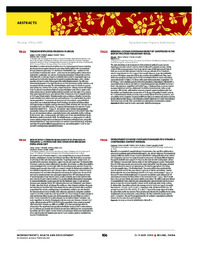The biofortification program in Brazil.
The biofortification program in Brazil.
Autoria: NUTTI, M.; CARVALHO, J.; FUKUDA, W.; PELOSO, M.; SCHAFFER, R.; NEVES, P.; ROCHA, M.; SILVA, J.; SCHEEREN, P.
Resumo: Most efforts to combat micronutrient deficiency in the developing world focus on providing vitamin and mineral supplements to the poor and on fortifying foods with these nutrients through postharvest processing. The introduction of biofortified crops - varieties bred for increased mineral and vitamin content - could complement existing nutrition interventions and provide a sustainable, low-cost way of combating malnutrition. In Brazil, the activities of the HarvestPlus Challenge Program on Biofortification and of the AgroSalud Program are coordinated by the Brazilian Agricultural Research Corporation (Embrapa), which includes a number of research centers that are part of the biofortification network. The difference between both programs is that AgroSalud focuses on the Latin America and the Caribbean, and also on post-harvest processing. The main food staples under research in Brazil are: cassava, sweet potato, rice, common beans, maize, cowpea and wheat . Embrapa Cassava and Tropical Fruits has already released two varieties of cassava with higher levels of beta-carotene and, in the last two years, is monitoring their performance in the semi-arid region of the country. Total carotenoid content in one-year old roots of the 72 landraces selected ranged from 0.63 to 15.51 ug.g-1 (fresh weight). Retention studies were carried out, at Brazilian Universities, in order to verify the â-carotene and total carotenoid losses in the usual Brazilian household cassava preparations. The production of bakery and extruded products, using biofortified cassava flour, was evaluated at Embrapa Food Technology .Researchers of Embrapa Maize and Sorghum implemented the quality protein maize (QPM), which has 50% more lysine and tryptophan; from these QPM varieties, it is expected the development of maize with higher levels of pro vitamin A (10 - 12 ug.g-1) , zinc and iron. Some common beans genotypes evaluated by Embrapa Rice and Beans, presented iron and zinc levels 50% and 43% higher than the ones of conventional cultivars, respectively; however, the productivity is still a challenge for the breeders. Also, a cowpea variety, with higher levels of iron was identified by Embrapa Mid-North and will be released in 2008.. Six biofortified crops are being produced locally for sensory analysis and agronomical performances in Maranhao and Sergipe States, along with antropometrical status Results presented here are based on a team work strategy, integrating more than 150 people in different geographical areas, and working tightly in order to reach HarvestPlus and AgroSalud expected deliverables.
Ano de publicação: 2009
Tipo de publicação: Parte de livro (capítulos de livros, trabalhos e resumos publicados em anais ou em coletâneas)
Unidade: Embrapa Hortaliças
Palavras-chave: AgroSalud, Biofortificação, Brasil, HarvestPlus, Mandioca, Microelemento, Nutriente, Nutrição, Planta, biofortification, cassava
Observações
1 - Por padrão são exibidas publicações dos últimos 20 anos. Para encontrar publicações mais antigas, configure o filtro ano de publicação, colocando o ano a partir do qual você deseja encontrar publicações. O filtro está na coluna da esquerda na busca acima.
2 - Para ler algumas publicações da Embrapa (apenas as que estão em formato ePub), é necessário ter, no celular ou computador, um desses softwares gratuitos. Sistemas Android: Google Play Livros; IOS: iBooks; Windows e Linux: software Calibre.
Acesse outras publicações
Acesse a Base de Dados da Pesquisa Agropecuária (BDPA) para consultar o acervo completo das bibliotecas da Embrapa.

